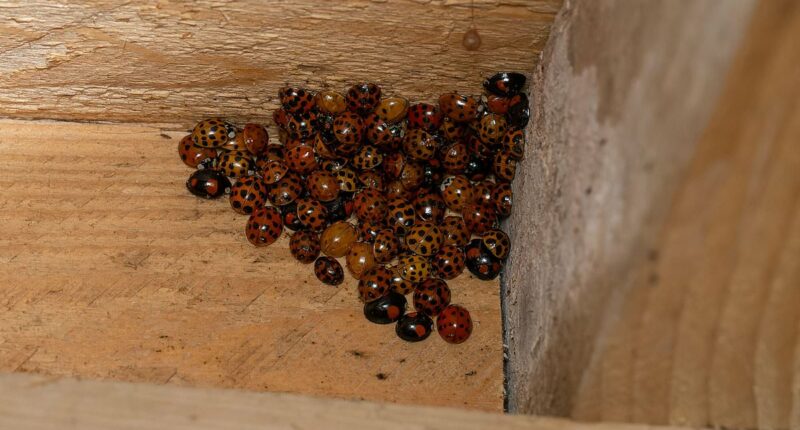Share this @internewscast.com
An invasive insect species, often mistaken for the benign ladybug, is making its way into American homes in overwhelming numbers, posing potential threats to residents.
Both state and federal authorities have issued warnings about the Asian lady beetle, which has emerged as a troublesome invader. Known to bite humans and cause damage to household infrastructure, this pest becomes particularly problematic during the cooler fall and winter months.
These beetles are notorious for forming massive swarms, sometimes called “death spirals,” which can be seen swirling around indoor lights. They congregate in vast numbers, often as many as 15,000 to 20,000, within the walls of homes.
In Mississippi, researchers have recently cautioned that these beetles are likely to start infiltrating homes again by squeezing through crevices such as window sills, in search of winter shelter.
However, this issue is not confined to Mississippi alone; the presence of Asian lady beetles has been reported across nearly every state in the country.
In addition to their unpleasant bite, these ladybug look-alikes release a yellow fluid when threatened. This substance has a strong, unpleasant odor, can irritate human skin, and may leave stains on various fabrics.
The PennState Extension warned: ‘It is not uncommon for tens of thousands of beetles to congregate in attics, ceilings and wall voids, and due to the warmth of the walls, will move around inside these voids and exit into the living areas of the home.’
The government-funded science advisors at Penn State added that the smelly yellow liquid could also trigger allergic reactions and sinus problems if the goo gets on someone’s skin.

The Asian lady beetle (Harmonia axyridis) is an invasive species that looks very similar to the US ladybug, bug can bite humans and infest homes

These insects gather by the thousands inside US homes in the fall and winter to escape the cold
Although the Asian lady beetle (Harmonia axyridis) was deemed an invasive species by the US Department of Agriculture (USDA) in the 2000s, the bugs were not carried here by accident or sent here by another nation to cause harm.
The US intentionally brought the beetles here over a century ago from countries including China, Russia, and Japan to fight native pests that were killing crops and plants.
Decades later, the USDA released thousands of the pest-eating lady beetles in places such as California, Georgia, and Pennsylvania, using them as a ‘biological control tool’ in the 1970s and 1980s.
However, their numbers quickly grew out of control, and by 1988, agriculture officials found the first confirmed lady beetle colonies living in Louisiana.
The Mississippi State University Extension explained: ‘During most of the year they are considered ‘good bugs,’ but as cold weather approaches, they start looking for a place to spend the winter, and this is when they can become real pests.’
Researchers from the University of Florida added that without the local predators, which eat lady beetles in Asia, their populations have exploded to the point where the pests are now endangering native ladybug species in the US.
Asian lady beetles are slightly bigger than normal ladybugs, and scientists have suspected that the invasive bugs are eating the eggs and larvae of US ladybugs in what they call acts of cannibalism.
US officials have grown increasingly concerned about the Asian lady beetle because as their population increases, native species die out, forcing farmers to rely more on pesticides that can pollute local water supplies.

While the normal ladybug is red with seven spots, Asian lady beetles are typically orange and have fewer markings

Asian lady beetles have spread to nearly every state in the US after being brought to the country to fight crop-killing pest in 1916
If the Asian beetles do start to gather in your home, retired MSU entomology specialist Black Layton warned against using insecticides to kill the creatures as these chemical sprays could end up lingering in your house without clearing the invasion.
‘The best advice I can give you once they get inside is to use a broom and a dustpan, or better yet, maybe a vacuum and just vacuum them up and get them outside,’ Layton said in a Facebook video.
As for how you can tell the normal ladybugs from the foul-smelling, biting variety, Asian lady beetles are often orange instead of red.
They also have fewer spots than the traditional seven you can count on the back of a deep red-colored US ladybug. Moreover, the Asian lady beetle has a distinct black ‘M’ or ‘W’-shaped mark on its head.
However, the biggest distinction is how the bugs interact with people. The slightly smaller US ladybug Americans are used to seeing in spring and summer does not bite at all.
They will crawl around on someone’s hand if picked up, but will never attack or release any type of defensive liquids.



